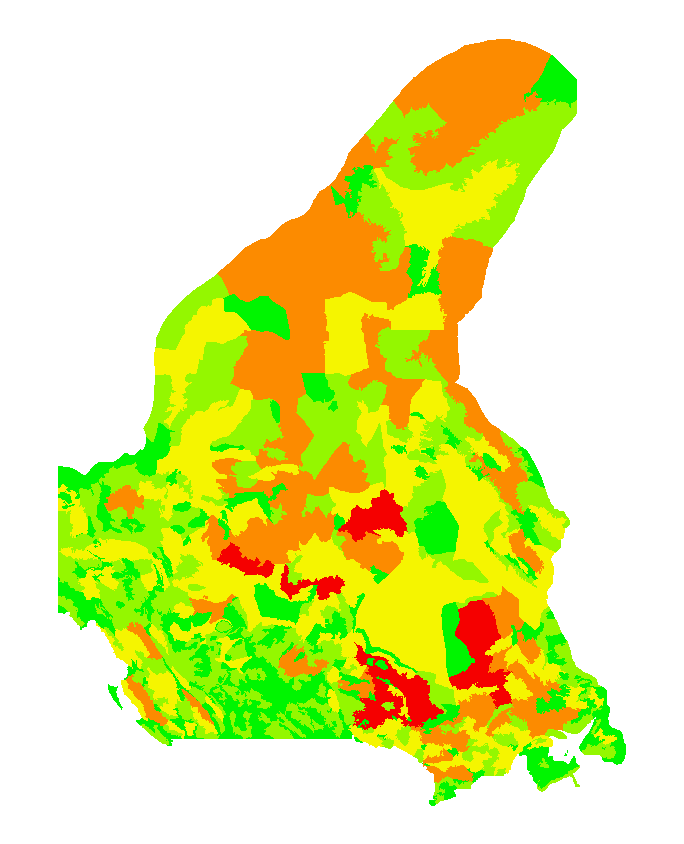Écologie
Type of resources
Available actions
Keywords
Contact for the resource
Provided by
Years
Representation types
Update frequencies
status
Service types
-

The National Ecological Framework for Canada's "Soil Texture by Ecozone” dataset contains tables that provide soil texture information within the ecozone framework polygon. It provides soil texture codes and their English and French language descriptions as well as the percentage of the polygon that the component occupies. Soil texture indicates the relative proportions of the various soil separates (sand, silt, clay) as described by classes of texture. Soil separates are mineral particles, 2.0 mm in diameter and include: gravel 0.2 -7.5 cm and cobbles 7.5-25.0 cm. There are 12 texture group classes definitions and one class definition for Not Applicable (which indicates, for example, water, ice or urban areas).
-

The National Ecological Framework for Canada's "Total Land and Water Area by Ecodistrict” dataset provides land and water area values for ecodistrict framework polygons, in hectares. It includes attributes for a polygon’s total area, land-only area and large water body area.
-

The National Ecological Framework for Canada's "Soil Development by Ecozone” dataset contains tables that provide soil development information for components within the ecozone framework polygon. It provides soil development codes and their English and French-language descriptions as well as the percentage of the polygon that the component occupies. The soil development descriptions are based on the second edition of the Canadian System of Soil Classification (Agriculture Canada Expert Committee on Soil Survey, 1987).
-

The National Ecological Framework for Canada's "Land Cover by Ecoregion” dataset provides land cover information within the ecoregion framework polygon. It provides landcover codes and their English and French language description as well as information about the percentage of the polygon that the component occupies.
-

The National Ecological Framework for Canada's "Elevation by Ecoregion” dataset provides elevation information for ecoregion framework polygons, in meters. It includes codes and descriptions for minimum elevation, maximum elevation, mean elevation and the difference in elevation.
-

The National Ecological Framework for Canada's "Surface Form by Ecoregion" dataset contains tables that provide surface form information for components within the ecoregion framework polygon. It provides surface form codes and their English and French-language descriptions as well as information about the percentage of the polygon that the component occupies. Surface form descriptions describe assemblages of slopes or recurring patterns of forms that occur at the earth's surface. When applied to consolidated materials (material that has been transformed to hard rock), it refers to the form produced after modification by geological processes. The mineral soil surface forms are: dissected; hummocky (irregular); inclined; level, rolling; ridged; steep; terraced; undulating. The wetland surface forms are: bog; fen; marsh; swamp.
-

The National Ecological Framework for Canada's "Landform by Ecodistrict” series contains tables that provide regional landform information for components within the ecodistrict framework polygon. It provides landform codes and their English and French-language descriptions as well as information about the percentage of the polygon that the component occupies. Regional landforms generally describe a region and include the various shapes of the land surface resulting from a variety of actions such as deposition or sedimentation (eskers, lacustrine basins), erosion (gullies, canyons), and earth crust movements (mountains). The regional landform classes are: plateau or tableland, hill and mountain, organic wetland, plain, scarp or valley.
-

The “Agro-Pedological Atlas of Quebec” is a dataset that shows the characteristics, the fertility, the quality of the water regime, the vulnerability to degradation and the potential of the agricultural soils and land in the Monteregian region of the province of Quebec.
-

The National Ecological Framework for Canada's "Land and Water Area by Province/Territory and Ecodistrict” dataset provides land and water area values by province or territory for the Ecodistrict framework polygon, in hectares. It includes codes and their English and French descriptions for a polygon’s province or territory, total area, land-only area and large water body area.
-

The “Terrestrial Ecodistricts of Canada” dataset provides representations of ecodistricts. An ecodistrict is a subdivision of an ecoregion and is characterized by distinctive assemblages of relief, landforms, geology, soil, vegetation, water bodies and fauna. For example, the Jeddore Lake ecodistrict (no. 473) is one of five ecodistricts within the Maritime Barrens ecoregion.
 Arctic SDI catalogue
Arctic SDI catalogue